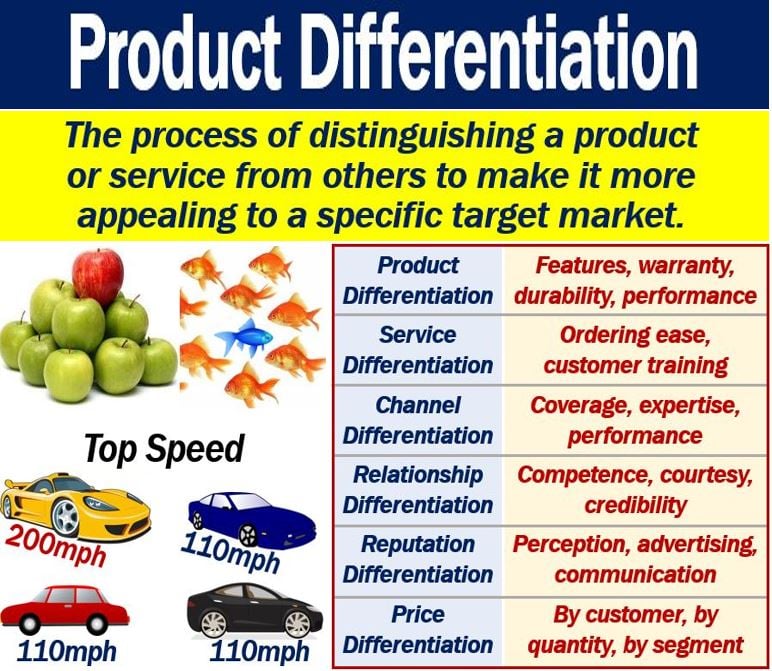Product Differentiation is a marketing process in which a product is differentiated from others. Put simply; it is the process of distinguishing a good or service from others, i.e., making it stand out. Companies do this because they want to show customers their product’s attributes and uniqueness. This may include products within the company or of the same line.
In this context, ‘marketplace’ means the same as ‘market’ in its abstract sense. Some people simply say ‘differentiation‘ with the meaning ‘product differentiation.’
If the company implements it successfully, product differentiation can give a good a competitive advantage. Competitive advantage means having an edge over rivals in the provision of a certain product or service.
Product differentiation – small companies
For small companies, this can be great. It can be useful because they then have a chance to compete against bigger companies. It also gives them a better chance to compete against more popular products.
Effective product differentiation, especially in saturated markets, can lead to brand loyalty as customers begin to associate unique qualities with a company’s offerings.
When differentiating a product from others, it does not necessarily have to be completely different or new.
Product differentiation may involve, promotions, product packaging, product design, quality, and extra features. Customer service, experience, and advertising campaigns are also relevant.
In the digital era, product differentiation extends beyond the physical attributes to include the online customer experience, which has become a pivotal aspect of modern marketing strategies.
In a 1997 Harvard Business Review article, ‘Discovering New Points of Differentiation,’ Rita Gunther McGrath and Ian MacMillan wrote:
“[Product differentiation is] offering customers something they value that competitors don’t have.”

Product differentiation types
There are three types of product differentiation.
Vertical differentiation
Vertical differentiation exists when consumers compare a product according to one feature – quality.
Consumers can say “Product A is better than Product B.”
For example, in the pharmaceutical industry, a person can decide whether to get a branded medication or a generic. They know the quality of each one.
A feature that also differentiates the two medications is ‘price.’ Brand names are much more expensive than generic medications.
Horizontal differentiation
With horizontal differentiation, the product is harder to classify because it has many features. Therefore, we only consider one characteristic.
Consumers are not certain about the quality of the products that they compare.
For example, when considering drinks, consumers may choose one because of its taste. However, they cannot determine which one is superior in quality.
When we choose between a Coke, Pepsi, or Dr. Pepper, for example, taste drives our decision. Regarding their quality, we have no idea which one is best.
Mixed differentiation
Mixed differentiation is a combination of both vertical and horizontal differentiation. It is common when consumers consider more complex products or marketing executives are looking at more sophisticated markets.
